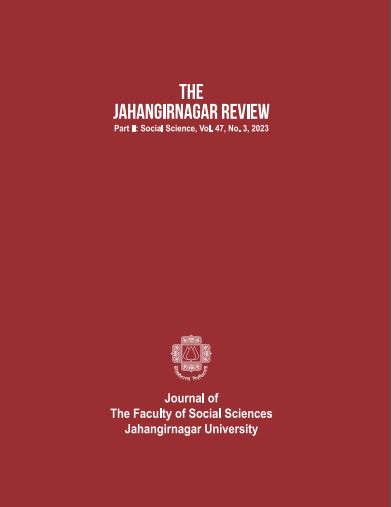Urban Heat Island Effect and Urban Density of Savar Municipality
Main Article Content
Abstract
This study critically examines the relationship between urbanization and Land Surface Temperature (LST) in the Savar Municipality area, employing Landsat 8 OLI + TIRS imageries and OpenStreetMap data. The Urban Heat Island (UHI) phenomenon, characterized by increased temperatures in urban areas compared to surrounding areas, has significant implications for environmental sustainability. The research objectives encompass a comprehensive analysis of UHI and urban building density using remote sensing and GIS algorithms, as well as an investigation into the correlation between UHI and urban building density within the study area.By employing advanced remote sensing techniques and GIS algorithms, this research uncovers important insights into the UHI effect and its association with urban development patterns in Savar Municipality. The analysis entails meticulous processing of satellite imagery, precise extraction of land cover information, rigorous calculation of LST values, and thorough examination of building density utilizing OpenStreetMap data. These methodologies ensure a robust and accurate assessment of the UHI phenomenon and its relation to urbanization. Point density calculation with fishnet method was used for analyzing the correlation between Urban Heat Island and the urban area building density of the study site. The highest temperature on 14th March 2014 was 310 C and the lowest one was 210 C where the maximum NDBI value was 0.137 and the minimum was -0.357. Again the highest temperature on 9th March 2018 is 290 C and the lowest one is 200 C where the maximum NDBI value is 0.163 and the minimum is -0.347. The highest temperature on 4th March 2022 was 300 C and the lowest one was 210 C where the maximum NDBI value was 0.156 and the minimum was - 0.3897. The correlation between LST and NDVI results is negative. In some parts of the study area where the urban density is higher , the temperature is comparatively lower. It is apparent that the green cover weakens the UHI effect. The correlation analysis conducted between UHI intensity and urban building density unravels a positive relationship, establishing the significance of urbanization patterns in shaping local temperature patterns. The areas with higher building density consistently exhibit heightened UHI effects, providing crucial evidence of the role played by urban development in exacerbating heat island phenomena.

